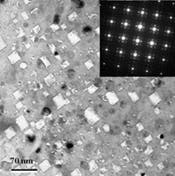NANOFABRICATION: Optical materials get smart
A research team at Oak Ridge National Laboratory (ORNL; Oak Ridge, TN), led by corporate fellow Lynn Boatner, is refining a technique that, in essence, can make otherwise inactive materials optically "smart." The concept involves building nanocomposite surfaces on inactive materials through ion implantation. When intense light hits these surfaces, it triggers a change in certain optical or magnetic properties.
Using an accelerator, Boatner and colleagues embed vanadium and oxygen ions in a crystalline aluminum oxide substrate surface. When this material is heated, the vanadium and oxygen ions diffuse and react to form embedded small particles of vanadium dioxide. When the particles are heated, they undergo a transition at a specific temperature that changes their properties. This change sends a signal to the near surface of the embedded aluminum oxide material so that it becomes sensitive to intense light and also develops the capability to change into both a reflective and opaque material.
In certain applications, this reactive capability can turn materials into what Boatner calls smart windows. When a material reacts like a smart window, intense light, which could be from a laser, strikes the nanocomposite surface, heating up the embedded vanadium oxide particles and transforming them into a metallic mirror-like state. Instead of letting the incoming light through, the window now reflects it back in the direction of its source. One possible application would be the shielding of delicate optical components from either accidental or intentional damage.
In addition to exploring the use of vanadium oxide nanocomposite surfaces as optical switches and attenuators, Boatner's team also has examined the nanocomposite material's potential as an optical data-storage material. Data storage may be possible because of the hysteretic nature of the material's semiconducting-to-metal phase transition. After exposure to an intense light, the material undergoes a hysteretic transformation, where the reflectivity of the surface does not return to exactly the same value it had before exposure to light. By thermally biasing the material on the branch of the hysteresis loop that initially occurs upon heating it, Boatner reports, it is possible to subsequently write information in the form of highly reflecting areas by optically heating selected areas of the material. The resulting highly reflective areas, which are retained on the branch of the hysteresis loop that occurs upon cooling, can subsequently be optically interrogated to read out the information.
Other applications
The ORNL smart-materials research is not limited to one type of nanocomposite. Tony Hayes of the laboratory's solid-state division, working with Boatner's group, has been studying iron nanocrystals implanted in yttrium-stabilized zirconia for its magnetic and ferromagnetic properties. Researchers Frank Modin and Shinich Honda showed that the intensity of specially polarized light passing through iron nanocrystals in this material changes when a magnetic field is applied (see image).
Other possible smart-material applications include using the nanocomposite materials to develop new devices based on fiberoptic, thin-film, and integrated-chip configurations. Working with the Vanderbilt University (Nashville, TN) finely focused ion-beam facility, researchers are collaborating with Len Feldman, an ORNL distinguished visiting scientist from Vanderbilt, to improve control over nanocrystal precipitate size and location in a matrix. According to Feldman, the ion-implantation equipment can implant atoms into dots as small as 5 nm at precisely controlled locations.
Paula Noaker Powell | Senior Editor, Laser Focus World
Paula Noaker Powell was a senior editor for Laser Focus World.
